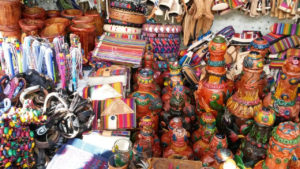Huipiles for everyday use
- 117 different huipiles from 117 municipalities, located in 17 of Guatemala’s 22 departamnts
- All are categorized for everyday use, with the exception of San Antonio Sacatepequez, the collection only has ceremonial huipiles from this municipio.
- The huipiles are grouped according to the language spoken in the country.
Traditional huipils generally identify the indigenous group and the community of the wearer as each has its own designs for both weaving and embroidering.
Women commonly have an everyday huipil and those worn only on special occasions such as weddings.Decorative elements are often arranged in horizontal bands but those with vertical orientation are found as well. In a number of indigenous communities, extravagant huipils made for a woman’s wedding is then carefully put away and stored to be used later for her funeral. In others, a special huipil is begun when a woman reaches a certain age for this purpose
Historical: San Pedro Ayampuc, Magdalena Milpas Altas and San Bartolome Milpas Altas. Some styles are on the verge of disappearing because of the very small number of weavers who remain active, such is the case of Acatenango and Santa Cruz Balanya, as well as Alotenango, San Miguel Dueñas and Santa Catarina Barahona.
In places such as Santa Catarina Palopo the transformation of the traditional style is so dramatic that it has given rise to new ones, which coexist with the huipil shown in the sample.
The sample includes several blouses, these towns would have been among the mos heavily influenced by the Spanish tradition brought with conquest and colonization beginning in 1524.
The tendency to wear blouses is also found in municipalities along Guatemala’s Pacific coast, where women went bare- breasted prior to the influence of foreign dress.
 Previous Post
Previous Post Next Post
Next Post


